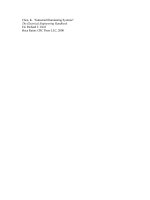Lecture Electrical Engineering: Lecture 31 - Dr. Nasim Zafar
Bạn đang xem bản rút gọn của tài liệu. Xem và tải ngay bản đầy đủ của tài liệu tại đây (723.59 KB, 31 trang )
COMSATS Institute of Information Technology
Virtual campus
Islamabad
Dr. Nasim Zafar
Electronics 1 EEE 231
Fall Semester – 2012
Lecture No. 31
v
v
Biasing in MOS Amplifier Circuits
and
v
9/24/18
SingleStage MOS Amplifiers
Dr. Nasim Zafar.
2
Biasing in MOS Amplifier Circuits
Lecture No. 31
v
Contents:
v
Voltage biasing scheme
v
Ø
Biasing by fixing voltage
Ø
Biasing with feedback resistor
Currentsource biasing scheme
9/24/18
Dr. Nasim Zafar.
3
Lecture No. 31
Biasing in MOS Amplifier Circuits
Reference:
Chapter 4.5
Microelectronic Circuits
Adel S. Sedra and Kenneth C. Smith.
9/24/18
Dr. Nasim Zafar.
4
Introduction
Ø
Ø
An essential step in the design of a MOSFET amplifier circuit
is the establishment of an appropriate dc operating point for
the transistor.
This is the step known as biasing or bias design.
9/24/18
Dr. Nasim Zafar.
5
Biasing by Fixing VGS
Ø
Ø
Ø
The most straightforward approach to biasing a MOSFET is to
fix its gatetosource voltage VGS to the value required to
provide the desired ID.
ID = 1/2kn’(W/L)(VGSVT)2
(4.20)
However, Biasing by fixing VGS is not a good technique.
9/24/18
Dr. Nasim Zafar.
6
Disadvantages of fixed biasing
Ø
The use of fixed bias
(constant VGS) can result in
a large variability in the
value of ID.
Fixing biasing may result in
large ID variability due to
deviation in device
performance
Ø
Ø
Ø
9/24/18
Dr. Nasim Zafar.
Current becomes
temperature dependent
Thus, Unsuitable biasing
method
7
Biasing using a Fixed Voltage at the Gate and a
Resistance in the Source
Ø
An excellent biasing technique for discrete MOSFET circuits
consists of fixing the dc voltage at the gate, VG, and
connecting a resistance in the source lead, as shown in
Fig.4.30(a). For this circuit we
VG=VGS+RS ID
Ø
(4.46)
Resistor Rs provides negative feedback, which acts to stabilize
the value of the bias current ID.
Ø
9/24/18
Dr. Nasim Zafar.
8
Rs gives it the name degeneration resistance.
Biasing using a Fixed Voltage at the Gate , VG
and a Resistance in the Source
Ø
Ø
Ø
Figure 4.30(b) provides a graphical illustration of the
effectiveness of this biasing scheme.
The intersection of this straight line with the iDVGS
characteristic curve, provides the coordinates (ID and VGS), of
the bias point.
compared to the case of fixed VGS, here the variability in ID is
much smaller.
Ø
9/24/18
Dr. Nasim Zafar.
9
Two possible practical discrete implementations of this bias
Biasing using a fixed voltage at the gate,
and a resistance in the source
Ø
Figure 4.30:
Ø
(a) The basic arrangement;
Ø
(b) Reduced variability in ID;
Ø
(c) Practical implementation using a single supply;
9/24/18
Dr. Nasim Zafar.
10
Biasing using a fixed voltage at the gate,
and a resistance in the source
Ø
Ø
(d) Coupling of a signal source to the gate using a capacitor CC1
(e) practical implementation using two supplies.
9/24/18
Dr. Nasim Zafar.
11
Biasing Using a DraintoGate Feedback Resistor
Ø
In Fig. 4.32, the large feedback resistance RG(usually in the
MΩ range) forces the dc voltage at the gate to be equal to that
at the drain (because IG=0). Thus we can write:
VGS = VDS = VDDRD ID
VDD = VGS + RD ID
Ø
(4.49)
which is identical in form to Eq. (4.46).
VG=VGS+RS ID
9/24/18
(4.46)
Dr. Nasim Zafar.
12
Biasing the MOSFET using a large Drain
toGate Feedback Resistance, RG
Figure 4.32: Biasing the MOSFET
using a large draintogate feedback
resistance, RG.
9/24/18
Dr. Nasim Zafar.
13
Biasing the MOSFET using a constantCurrent
Source I.
Ø
Ø
Ø
The most effective scheme for biasing a MOSFET amplifier is
that using a constantcurrent source.
Figure 4.33(a) shows such an arrangement applied to a
discrete MOSFET.
A circuit for implementing the constantcurrent source I is
shown in Fig. 4.33(b).
This circuit, known as a current mirror, is very popular in
9/24/18
Dr. Nasim Zafar.
14
the design of IC MOS amplifiers.
Ø
Biasing the MOSFET using a constant
Current Source I.
Figure 4.33
(a)
(b)
Biasing the MOSFET using a constantcurrent source I.
Implementation of the constantcurrent source I using a current
mirror.
9/24/18
Dr. Nasim Zafar.
15
SingleStage MOS Amplifiers
Lecture No. 31
v Contents:
v Basic structure
v Characteristic parameters
v Three configurations:
Ø
Commonsource configuration
Ø
Commondrain configuration
Ø
Commongate configuration
9/24/18
Dr. Nasim Zafar.
16
Basic Structure of the Circuit
Basic structure of the circuit
used to realize singlestage
discretecircuit MOS
amplifier configurations.
9/24/18
Dr. Nasim Zafar.
17
Characteristic Parameters of Amplifier
9/24/18
Ø
This is the twoport network of amplifier.
Ø
Voltage signal source.
Ø
Output signal is obtained from the load resistor.
Dr. Nasim Zafar.
18
The CommonSource (CS) Amplifier
Ø
Ø
Ø
Ø
9/24/18
Dr. Nasim Zafar.
Commonsource amplifier
based on the circuit of
basic structure.
Biasing with constant
current source.
CC1 And CC2 are
coupling capacitors.
CS is the bypass capacitor.
19
Equivalent Circuit of the CS Amplifier
9/24/18
Dr. Nasim Zafar.
20
Summary of CS Amplifier
v
Very high input resistance
v
Moderately high voltage gain
v
Relatively high output resistance
9/24/18
Dr. Nasim Zafar.
21
The CommonGate Amplifier Circuit
Ø
Ø
Ø
Ø
Ø
9/24/18
Dr. Nasim Zafar.
Biasing with constant
current source I
Input signal vsig is
applied to the source
Output is taken at the
drain
Gate is signal grounded
CC1 and CC2 are
coupling capacitors
22
The CommonGate Amplifier
ØA smallsignal
equivalent circuit of the
amplifier in fig. (a).
ØT model is used in
preference to the π model
ØNeglecting ro
9/24/18
Dr. Nasim Zafar.
23
Summary of CG Amplifier
Ø
Noninverting amplifier.
Ø
Low input resistance.
Ø
Has nearly identical voltage gain of CS amplifier, but the
overall voltage gain is smaller by the factor (1+gmRsig ) .
Ø
Relatively high output resistance.
Ø
Current follower.
Superior highfrequency performance.
9/24/18
Dr. Nasim Zafar.
Ø
24
The CommonDrain or SourceFollower
Amplifier
Biasing with current source
Input signal is applied to gate, output signal is taken at the source.
9/24/18
Dr. Nasim Zafar.
25









